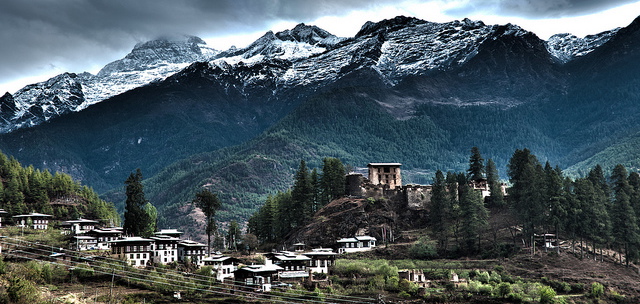Bhutan: A Case Study of Narendra Modi’s Foreign Policy

Unlike his predecessor, Prime Minister Narendra Modi has been paying increased attention to India’s neighbour Bhutan which, despite not being a very strong ally, could be crucial for Modi’s regional strategy.
Modi chose to visit Bhutan as his first official diplomatic venture since his crushing election victory in May. This was notable because Bhutan had, during the previous Indian regime of prime minister Manmohan Singh, only featured in India’s priority zone as an aid receiver for regional diplomacy. The impoverished Himalayan kingdom had never been a neighbour important enough to deserve the first encounter. This raises the question whether this was a carefully crafted, conscious diplomatic decision by Modi, or a mere gesture of generosity towards his motive of ‘political stability, progress and peace’ in the region.
Located at the eastern end of the Himalayas and bordered to the north by the People’s Republic of China and to the south, east and west by the Democratic Republic of India, Bhutan stands to be a ‘triple buffer state’ between India and its crucial neighbours Nepal, Bangladesh and China.
In addition Bhutan is important for India as it is close to the narrow ‘Chicken’s Neck’ corridor, the sole connection between the Indian mainland and the Northeast. Thus Bhutan provides a crucial link between Indian governance and the country’s perennially disturbed northeastern region.
The Issue of Insurgency
Despite the lapse of two decades of India’s ‘Look East’ policy, the northeastern parts of India remain in a deplorable state in terms of their social, political and economic condition. They suffer because of a highly centralised governance system, an elitist bureaucracy, limited employment options, large scale insurgencies and poor standards of living. India’s northeastern population has a religious connection with its Bhutanese counterpart through Buddhism. Meanwhile the ruling Bharatiya Janata Party, built on clear Hindu beliefs and ideology, is struggling in its attempt to morph into a secular mould.
So far the Indian Government has been largely unsuccessful in soothing the frequent and violent demands to secede on account of cultural, social and economic alienation by these states. Better governance and infrastructural development through inclusion is a must for inducing a feeling of oneness in the northeastern Indians, especially on the occasion of their geographical proximity and cultural affinity with powerful, adversarial neighbours.
Insurgency is a sensitive issue across India’s northeastern borders at large. The construction of new roadways between the Northeast and Bhutan will not only reduce transport costs incurred through longer routes of the well-developed states, but also lead to the installation of new security forces, thus contributing to combating insurgency.
Fostering Inclusion and Unity
Student and cultural exchanges between India and Bhutan will also produce new leaders for Bhutan and help foster a sense of inclusion and security in the Buddhist and northeastern communities of India. On his recent visit to Bhutan, Modi, announced a doubling of scholarships for Bhutanese students in India. Tourism initiatives between India’s north and Bhutan across the beautiful Himalayan belt can play a key role in socio-economic progress through the creation of new enterprise and employment opportunities, infrastructure development and foreign exchange earnings.
In addition, India is set to launch the ‘National Mission on Himalayas’,an inter-governmental partnership to coordinate policy making and capacity building across states to create a ‘Himalayan Sustainability Fund’. There are plans to build a central university dedicated to furthering programs to arrest the melting of Himalayan glaciers from which most of the rivers in North India originate. States like Bhutan and Nepal are sure to benefit financially, culturally and politically as these initiatives are likely to elevate the human development indices of both nations. In its turn, Bhutan is blessed with several fast flowing rivers which can be excellent sources of hydroelectricity and Bhutanese power projects are capable of providing clean and green energy to India.
A New Focus on Neighbourhood
There are both pros and cons to NarendraModi’s policy of focusing on neighbourhood without chasing great powers. In the modern era, India has carved a niche for itself in world affairs. Thus it would seem rather imprudent to lapse back into a narrow regional focus. After all, the main reason Indian investment has roused interests among its neighbours is due to the country’s emergence as an important player in the international system.
On the other hand, India’s neighbourhood has been in a state of flux in recent years and development and change are likely to continue. Although China is economically stronger, India is a democracy and therefore politically in a better position to take a proactive role in these transitions. Bhutan, as of 2013, has no formal diplomatic ties with China due to unresolved border disputes. From the Kautiliyan model, Bhutan, though not a very powerful ally, stands to be crucial for India in its China containment strategy. Nevertheless the great powers are working fast and it is critical for India to make progress in this seemingly trivial, yet latently significant, Indo-Bhutan relationship.
Abhismita Sen is currently interning with the Planning Commission, Government of India and will start her Masters in Comparative Politics at the London School of Economics and Political Science in October 2014.





